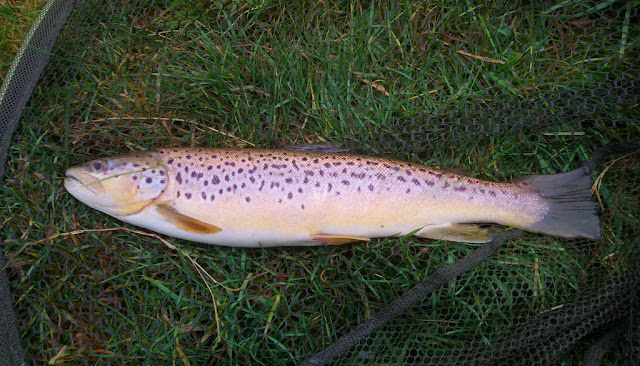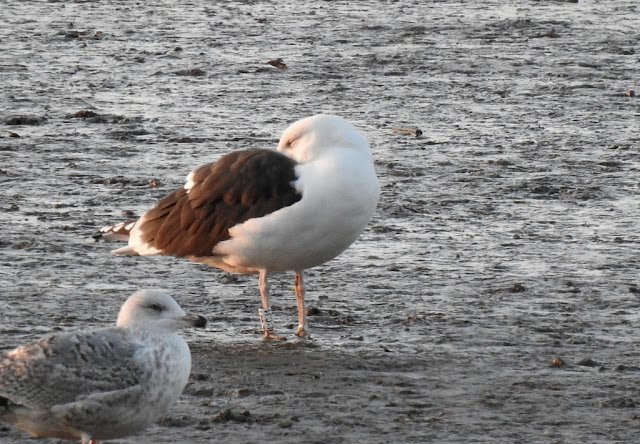A bit of overnight babysitting last Sunday/Monday has resulted in my third
rotten cold in just over three months. It really kicked in on Friday night,
and this weekend I feel lousy. I love my granddaughters, but they are
festering little germ factories. Anyway, for some reason, feeling lousy has
put me in the mood finally to get this post written. It relates to events
which occured back in August. Not my finest hour, but worth airing I think...
During the first three weeks of August 2021, passerine migrants were mostly
few and far between. A sprinkling of Wheatears,
Willow Warblers and whatnot, but a Whinchat on 21st was my first
of the autumn. And then the wind finally shifted into an easterly quarter,
and it felt like a blockage had been removed. At Cogden on the 23rd, migrants were getting through at last. Yellow Wagtails, several
Whinchats, Tree Pipits, a steady stream of hirundines. It
suddenly felt very birdy.
Standing on the beach that morning, I peered out to sea and had a scan. A long, long way
out I could see what looked suspiciously like a falcon, low over the water.
Only a few days earlier I'd watched a Peregrine well out to sea repeatedly stooping at
a passerine, which it then chased unsuccessfully all the way
to shore. I assumed this bird was going to be a Peregrine too. As it
got closer I made a rather pointless effort to get photos, just a burst of
three. Daft really, it was still a dot. So I continued to watch it approach,
and as it looked likely to hit land just to the west of my position, save
another photographic attempt until then.
And then suddenly I began to wonder if it wasn't actually a
Peregrine after all, and in just a few seconds went from total composure to blind panic. At closer range it looked long-tailed, with a dusky
underwing and a rich, tawny-coloured body; and the unthinkable occured to me.
Could this be an Eleonora's Falcon?! It reminded me so much of the
light phase Eleonora's painting in the Collins Bird Guide. As it crossed the beach I had one chance at getting photos. In my flustered
state I failed to get the camera to focus properly, and fluffed it. The bird
headed away inland without even pausing. I checked my pics. Seven frames of
blurry rubbish. What now?
Well, my instinct was to write the whole thing off as one of those moments you
wish had never happened, and forget it. But if it was an
Eleonora's Falcon I would have felt very bad if it had turned up
somewhere else and I hadn't even given a heads-up to Mike and Alan at West
Bex. So I phoned Mike and told him the story. I then posted one photo on the
local WhatsApp group and asked for opinions, and a short while later was on
the phone to Steve with my tale of woe. Personally I wanted to bury it, but
Steve suggested I stick it on Twitter, for exactly the same reason that I had
felt obliged to call Mike. I wasn't keen, but did so anyway...

|
The photo was taken at 07:55
|
There are birders who can sit among a group of strangers at a seawatch and
boldly call out passing birds - even on brief, uncertain views - simply to
make sure nobody misses anything. I admire them, but I am not one of them. I
don't mind making mistakes in front of friends who know me, but a loud and
public cock-up is not my idea of fun, so I tend not to risk it. Let me tell
you, posting that tweet felt like all kinds of unpleasant exposure.
I had never seen Eleonora's Falcon, but was aware they should show a
strong contrast between dark coverts and the remainder of the underwing. In
the photo I could see some contrast. But strong? I didn't think
so, but maybe it wasn't so obvious in young birds? I simply didn't know. The response on Twitter was
interesting. For a start, BirdGuides picked it up very quickly and posted the
sighting as 'possible Eleonora's Falcon'. That they hadn't immediately
dismissed it on the evidence of that photo was encouraging, and I was glad
Steve had persuaded me to publicise it after all. Quite a few other responses
were positive too, in a cautious kind of way, especially early on. As the day
progressed however, a few 'it's a Peregrine' type replies appeared, one or two
including some reasons why. Like this helpful example from Jason Moss...

To be quite honest, Jason's reply in the afternoon had unwittingly squashed
the one slim hope I still clung to - that it might be a juvenile, thereby
explaining the minimal contrast between underwing coverts and flight feathers.
It hadn't occured to me that it was much too early for juvs to be on the wing.
Another disheartening tweet was this one from StonefactionBirding...
The similarity was obvious, and by this stage I had resigned myself to the
inevitable. Meanwhile, Sam Viles at BirdGuides had kindly sent all ten of my
photos to a couple of raptor experts, Andrea Corso and Dick Forsman, for their
opinion. Here are six of the 'better' ones...
They replied as follows...

|
The final nails...
|
So there you have it. Quite a rollercoaster. From 'have I just fluffed the
only chance I'll ever get at a UK Eleonora's Falcon?' to 'oh, maybe
there's actually enough in my photos to save it after all?' to 'oh no, there's
actually enough in my photos to kill it stone dead, and I should have worked
that out for myself'. In the end there was a spurious satisfaction to be had
from knowing for sure that it was a Peregrine, but that was absolutely
no consolation. I felt pretty bad. Still, it taught me a couple of lessons...
1. There is a wealth of willing expertise out there, easily accessible via
social media.
2. Always know when juveniles fledge.
Would I do the same again? Well, I clearly remember how I felt during that
bird's final approach to the shore and my fumbled attempt at photos, and as it
powered away inland. A combination of adrenaline and immense guttedness. I
really thought I might have let a very rare bird slip through my fingers. If
an Eleonora's Falcon had indeed turned up somewhere later that day and
I hadn't said anything to anyone I would have been kicking myself, as well as
feeling guilty that I hadn't given fellow birders a heads-up. So what if the
final outcome left me feeling a bit foolish? Yes, I would probably do it
again. And after all, it's not every day that you get to be responsible for
one of these:












































